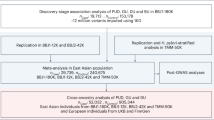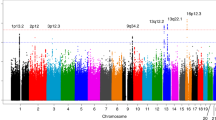Abstract
Through a genome-wide association analysis with a total of 7,035 individuals with duodenal ulcer and 25,323 controls from Japan, we identified two susceptibility loci at the PSCA gene (encoding prostate stem cell antigen) at 8q24 and at the ABO blood group locus at 9q34. The C allele of rs2294008 at PSCA was associated with increased risk of duodenal ulcer (odds ratio (OR) = 1.84; P = 3.92 × 10−33) in a recessive model but was associated with decreased risk of gastric cancer (OR = 0.79; P = 6.79 × 10−12), as reported previously1. The T allele of rs2294008 encodes a translation initiation codon upstream of the reported site and changes protein localization from the cytoplasm to the cell surface. rs505922 at ABO was also associated with duodenal ulcer in a recessive model (OR = 1.32; P = 1.15 × 10−10). Our findings demonstrate a role for genetic variants in the pathogenesis of duodenal ulcer.
This is a preview of subscription content, access via your institution
Access options
Subscribe to this journal
Receive 12 print issues and online access
$209.00 per year
only $17.42 per issue
Buy this article
- Purchase on Springer Link
- Instant access to full article PDF
Prices may be subject to local taxes which are calculated during checkout



Similar content being viewed by others
References
Sakamoto, H. et al. Genetic variation in PSCA is associated with susceptibility to diffuse-type gastric cancer. Nat. Genet. 40, 730–740 (2008).
Wyatt, J.I., Rathbone, B.J., Dixon, M.F. & Heatley, R.V. Campylobacter pyloridis and acid induced gastric metaplasia in the pathogenesis of duodenitis. J. Clin. Pathol. 40, 841–848 (1987).
Helicobacter and Cancer Collaborative Group. Gastric cancer and Helicobacter pylori: a combined analysis of 12 case control studies nested within prospective cohorts. Gut 49, 347–353 (2001).
Hopkins, R.J., Girardi, L.S. & Turney, E.A. Relationship between Helicobacter pylori eradication and reduced duodenal and gastric ulcer recurrence: a review. Gastroenterology 110, 1244–1252 (1996).
Schlemper, R.J., van der Werf, S.D., Vandenbroucke, J.P., Biemond, I. & Lamers, C.B. Peptic ulcer, non-ulcer dyspepsia and irritable bowel syndrome in The Netherlands and Japan. Scand. J. Gastroenterol. Suppl. 200, 33–41 (1993).
Araki, S. & Goto, Y. Peptic ulcer in male factory workers: a survey of prevalence, incidence, and aetiological factors. J. Epidemiol. Community Health 39, 82–85 (1985).
Khuroo, M.S., Mahajan, R., Zargar, S.A., Javid, G. & Munshi, S. Prevalence of peptic ulcer in India: an endoscopic and epidemiological study in urban Kashmir. Gut 30, 930–934 (1989).
Kurata, J., Nogawa, A., Watanabe, Y. & Kawai, K. Peptic ulcer disease mortality. Comparison of native Japanese, Japanese Americans, and Caucasian Americans. J. Clin. Gastroenterol. 18, 145–154 (1994).
Hansson, L.E. et al. The risk of stomach cancer in patients with gastric or duodenal ulcer disease. N. Engl. J. Med. 335, 242–249 (1996).
Kusters, J.G., van Vliet, A.H. & Kuipers, E.J. Pathogenesis of Helicobacter pylori infection. Clin. Microbiol. Rev. 19, 449–490 (2006).
Ainley, C.C., Forgacs, I.C., Keeling, P.W. & Thompson, R.P. Outpatient endoscopic survey of smoking and peptic ulcer. Gut 27, 648–651 (1986).
Räihä, I., Kemppainen, H., Kaprio, J., Koskenvuo, M. & Sourander, L. Lifestyle, stress, and genes in peptic ulcer disease: a nationwide twin cohort study. Arch. Intern. Med. 158, 698–704 (1998).
Kamatani, Y. et al. Genome-wide association study of hematological and biochemical traits in a Japanese population. Nat. Genet. 42, 210–215 (2010).
Clausen, H. & Hakomori, S. ABH and related histo-blood group antigens; immunochemical differences in carrier isotypes and their distribution. Vox Sang. 56, 1–20 (1989).
Walker, M.M. & Dixon, M.F. Gastric metaplasia: its role in duodenal ulceration. Aliment. Pharmacol. Ther. 10 (suppl. 1), 119–128 (1996).
Gu, Z. et al. Prostate stem cell antigen (PSCA) expression increases with high gleason score, advanced stage and bone metastasis in prostate cancer. Oncogene 19, 1288–1296 (2000).
Saeki, N., Gu, J., Yoshida, T. & Wu, X. Prostate stem cell antigen: a Jekyll and Hyde molecule? Clin. Cancer Res. 16, 3533–3538 (2010).
Wu, X. et al. Genetic variation in the prostate stem cell antigen gene PSCA confers susceptibility to urinary bladder cancer. Nat. Genet. 41, 991–995 (2009).
Nakai, K. & Kanehisa, M. A knowledge base for predicting protein localization sites in eukaryotic cells. Genomics 14, 897–911 (1992).
Edgren, G. et al. Risk of gastric cancer and peptic ulcers in relation to ABO blood type: a cohort study. Am. J. Epidemiol. 172, 1280–1285 (2010).
Nakao, M. et al. ABO genotype and the risk of gastric cancer, atrophic gastritis, and Helicobacter pylori infection. Cancer Epidemiol. Biomarkers Prev. 20, 1665–1672 (2011).
Marra, E. et al. Growth delay of human bladder cancer cells by Prostate Stem Cell Antigen downregulation is associated with activation of immune signaling pathways. BMC Cancer 10, 129 (2010).
Gu, Z., Yamashiro, J., Kono, E. & Reiter, R.E. Anti-prostate stem cell antigen monoclonal antibody 1G8 induces cell death in vitro and inhibits tumor growth in vivo via a Fc-independent mechanism. Cancer Res. 65, 9495–9500 (2005).
Raff, A.B., Gray, A. & Kast, W.M. Prostate stem cell antigen: a prospective therapeutic and diagnostic target. Cancer Lett. 277, 126–132 (2009).
Ohara, T., Morishita, T., Suzuki, H., Masaoka, T. & Ishii, H. Perforin and granzyme B of cytotoxic T lymphocyte mediate apoptosis irrespective of Helicobacter pylori infection: possible act as a trigger of peptic ulcer formation. Hepatogastroenterology 50, 1774–1779 (2003).
Yamamoto, F., Clausen, H., White, T., Marken, J. & Hakomori, S. Molecular genetic basis of the histo-blood group ABO system. Nature 345, 229–233 (1990).
Nakao, M. et al. ABO blood group alleles and the risk of pancreatic cancer in a Japanese population. Cancer Sci. 102, 1076–1080 (2011).
Fujita, Y., Tanaka, K. & Tanimura, M. The distribution of the Rh(D) blood types in Japan. Jinrui Idengaku Zasshi 23, 197–209 (1978).
Clarke, C.A. et al. The relationship of the ABO blood groups to duodenal and gastric ulceration. BMJ 2, 643–646 (1955).
Amundadottir, L. et al. Genome-wide association study identifies variants in the ABO locus associated with susceptibility to pancreatic cancer. Nat. Genet. 41, 986–990 (2009).
Reilly, M.P. et al. Identification of ADAMTS7 as a novel locus for coronary atherosclerosis and association of ABO with myocardial infarction in the presence of coronary atherosclerosis: two genome-wide association studies. Lancet 377, 383–392 (2011).
Harris, J.B. et al. Blood group, immunity, and risk of infection with Vibrio cholerae in an area of endemicity. Infect. Immun. 73, 7422–7427 (2005).
Aspholm-Hurtig, M. et al. Functional adaptation of BabA, the H. pylori ABO blood group antigen binding adhesin. Science 305, 519–522 (2004).
Wu, T.C., Chen, L.K. & Hwang, S.J. Seroprevalence of Helicobacter pylori in school-aged Chinese in Taipei City and relationship between ABO blood groups. World J. Gastroenterol. 9, 1752–1755 (2003).
Nakamura, Y. The BioBank Japan Project. Clin. Adv. Hematol. Oncol. 5, 696–697 (2007).
Tajima, K. et al. A model of practical cancer prevention for out-patients visiting a hospital: the hospital-based epidemiologic research program at Aichi Cancer Center (HERPACC). Asian Pac. J. Cancer Prev. 1, 35–47 (2000).
Purcell, S. et al. PLINK: a tool set for whole-genome association and population-based linkage analyses. Am. J. Hum. Genet. 81, 559–575 (2007).
Breslow, N.E. & Day, N.E. Statistical methods in cancer research. Volume II–The design and analysis of cohort studies. IARC Sci. Publ. 1–406 (1987).
Scott, L.J. et al. A genome-wide association study of type 2 diabetes in Finns detects multiple susceptibility variants. Science 316, 1341–1345 (2007).
Tanikawa, C. et al. Regulation of protein Citrullination through p53/PADI4 network in DNA damage response. Cancer Res. 69, 8761–8769 (2009).
Barrett, J.C., Fry, B., Maller, J. & Daly, M.J. Haploview: analysis and visualization of LD and haplotype maps. Bioinformatics 21, 263–265 (2005).
Acknowledgements
We thank all the subjects and the members of the Rotary Club of Osaka-Midosuji District 2660 Rotary International in Japan, who donated their DNA for this work. We also thank A. Matsui and H. Tagaya and the technical staff of the Laboratory for Genotyping Development at the Center for Genomic Medicine at RIKEN for their technical support. This work was conducted as a part of the BioBank Japan Project, which was supported by the Ministry of Education, Culture, Sports, Science and Technology of the Japanese government.
Author information
Authors and Affiliations
Contributions
C.T., Y.N. and K. Matsuda conceived and designed the study. Y.U., K. Matsuo and M.K. performed genotyping. A.T. and N.K. performed quality control analysis for the GWAS. Y.N., K. Matsuda and M.K. managed DNA samples belonging to BioBank Japan. H.I. and K.T. managed DNA samples from the Aichi Cancer Center. C.T. analyzed and summarized all the results. C.T., Y.N. and K. Matsuda wrote the manuscript. Y.N. obtained funding for the study.
Corresponding author
Ethics declarations
Competing interests
The authors declare no competing financial interests.
Supplementary information
Supplementary Text and Figures
Supplementary Figures 1–7, Supplementary Tables 1–14 and Supplementary Note (PDF 1060 kb)
Rights and permissions
About this article
Cite this article
Tanikawa, C., Urabe, Y., Matsuo, K. et al. A genome-wide association study identifies two susceptibility loci for duodenal ulcer in the Japanese population. Nat Genet 44, 430–434 (2012). https://doi.org/10.1038/ng.1109
Received:
Accepted:
Published:
Issue Date:
DOI: https://doi.org/10.1038/ng.1109
This article is cited by
-
Spatial and temporal diversity of positive selection on shared haplotypes at the PSCA locus among worldwide human populations
Heredity (2023)
-
Blueberry anthocyanin extracts protect against Helicobacter pylori-induced peptic epithelium injuries both in vitro and in vivo: the key role of MAPK/NF-κB pathway
European Journal of Nutrition (2022)
-
Genome-wide association study of colorectal polyps identified highly overlapping polygenic architecture with colorectal cancer
Journal of Human Genetics (2022)
-
Genome-wide association study of COVID-19 severity among the Chinese population
Cell Discovery (2021)
-
Lifestyles, genetics, and future perspectives on gastric cancer in east Asian populations
Journal of Human Genetics (2021)



